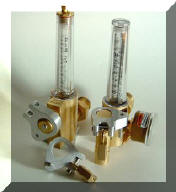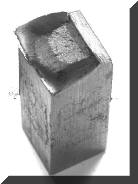Effective Welding Heat Input |
|
 Alert
!! Alert
!!
Argon
Prices Increasedd Over Double in Past Few Years
(See Details in Video)
Time to "Lock" Your Flowmeters with Our Flow Rate Limiter.
The Flow
Rate Limiter (FRL) is our latest gas saving patent. It
simply clamps on to and locks the flowmeter knob. It does not alter the flowmeter.
CLICK Here or Picture for Details.
Our FRL is a Perfect Compliment to Our
Gas Saver System (GSS.)
With Both You'll Save Over 50 to 60% of Shielding Gas Use! |
|
ISSUES MEASURING HEAT INPUT
Many weld
properties are dependent on welding heat input. Quenched and tempered
(Q&T) steels achieve optimum strength and impact properties through heat
treatment. When Q&T steels are welded the area adjacent to the weld deposit
is heated almost to the melting point of steel. Mechanical properties are
particularly changed and mostly degraded as this area experiences
temperature to about 1300 degrees F. |
|
 These
structural changes in the material are sufficient that a chemical etch will
alter the appearance of this zone from almost melting to about 1300 degrees
F. This is called the Heat Affected Zone or HAZ. The line that demarks
the plate that reached the 1300 degree F point is referred to as the outer
etching boundary. These
structural changes in the material are sufficient that a chemical etch will
alter the appearance of this zone from almost melting to about 1300 degrees
F. This is called the Heat Affected Zone or HAZ. The line that demarks
the plate that reached the 1300 degree F point is referred to as the outer
etching boundary. |
|
ISSUES RELATED TO HEAT INPUT CALCULATIONS
Maximum
allowable "Heat Input" is often specified in welding codes. A
simple
(Volts x Amps)/ Travel approach is used to define this parameter but
does not consider the more complex issues such as arc efficiency, effects of
oscillation or how to handle multiple wire processes. In addition issues
arise about how to measure short circuiting MIG or Pulsed MIG amps and
volts. With these processes there are wide variations in both parameters at
frequencies of 200 cycles per second or more. |
|
A SOLUTION DEFINED
Two examples are presented
which show how employing a weld cooling rate approach developed by Professor
Mel Adams was used to show that "Effective Heat Input" can be easily
determined.
 One
example shows how this "Effective Heat Input" approach was used when
surfacing an HY-80 Navy vessel using a Plasma Hot Wire process . How
this 50% arc efficiency process and the effects of oscillation were defined.
Another defines Oscillated MIG and Multiwire Submerged Arc Processes were
handled. One
example shows how this "Effective Heat Input" approach was used when
surfacing an HY-80 Navy vessel using a Plasma Hot Wire process . How
this 50% arc efficiency process and the effects of oscillation were defined.
Another defines Oscillated MIG and Multiwire Submerged Arc Processes were
handled. |
|
SIMPLE METHOD DEFINED
Professor Adams developed
this simple method of defining "Effective Heat Input." It is easy to
apply with simple weld cross sections and easy to measure parameters.
Paraphrasing Professor Adams conclusions: “Equations were developed that
are considered particularly accurate for calculating temperatures between
two known reference locations such as the fusion boundary and the
characteristic etching boundary; in this circumstance there is no need to
know knowledge of the arc energy is required.”
“Characteristic etching boundaries in H-80 and T-1 steels are associated
with specific peak temperatures regardless of cooling rate, preheat, arc
energy or geometry.” |
|
DETAILED REPORT AVAILABLE
A report is available that presents full
details on how this information was used and how to apply the approach to
handle other process variations as would occur with Hybrid MIG, Tandem MIG
etc.
Click ICON for PDF Download
of "Effective Weld Heat Input" |
|
MEASURING AMPS AND VOLTS
The welding industry is lacking in
effective means of accurately measuring amps and volts. Without
accurate measurements calculating "Heat Input" is not possible. An
example is shown where voltage measurements can be easily changed just by
altering the location of the voltage pick-up leads relative to the power
cables. Methods of improving this situation are also shown in the
above referenced report. |
|
 Having
Variations in Chary Impact Test Results? Having
Variations in Chary Impact Test Results?
We did also. We found out why
the same weldment achieved 45 ft-lbs and 7 ft-lbs in the same deposit!
Want to know why?
Check Out
This Web Page |

Purchase Gas Saving Products |

Purchase Training Aids |

Purchase
Flow Rate Limiter |

Purchase Wire Feeding
Aids |
|
▲ HOME
►GSS
Purchase |
|